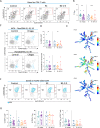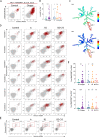Chagasic cardiomyopathy is marked by a unique signature of activated CD4+ T cells
- PMID: 36447264
- PMCID: PMC9708147
- DOI: 10.1186/s12967-022-03761-5
Chagasic cardiomyopathy is marked by a unique signature of activated CD4+ T cells
Abstract
Chagas disease is a neglected tropical disease in Latin America and an imported emerging disease worldwide. Chronic Chagas disease cardiomyopathy (CCC) is the most prominent clinical form and can lead to heart failure, thromboembolism, and sudden death. While previous reports have supported a role for CD4+ T lymphocytes in the pathogenesis of CCC a comprehensive analysis of these cells during different clinical forms is lacking. Here, we used high-dimensional flow cytometry to assess the diversity of circulating CD4+ T cells in patients with distinct clinical forms. We found increased frequencies of CD4+CD69+ T cells in patients compared to controls. CD39+ regulatory T cells, represented by mesocluster 6 were reduced in mild CCC patients compared to controls. Cytotoxic CD4+ T cells co-expressing granzyme B and perforin were expanded in patients with Chagas disease and were higher in patients with mild CCC compared to controls. Furthermore, patients with mild CCC displayed higher frequencies of multifunctional effector memory CD4+ T cells. Our results demonstrate an expansion in activated CD4+ T cells and a decrease in a functional subset of regulatory T cells associated with the onset of Chagas cardiomyopathy, suggesting their role in the establishment of cardiac lesions and as potential biomarkers for disease aggravation.
Keywords: Biomarkers; CD4+ T cells; Cardiomyopathy; Chagas disease; Cytotoxic; Multifunctional; Regulatory; Trypanosoma cruzi.
© 2022. The Author(s).
Conflict of interest statement
The authors declare that they have no competing interests.
Figures







References
Publication types
MeSH terms
LinkOut - more resources
Full Text Sources
Medical
Research Materials

